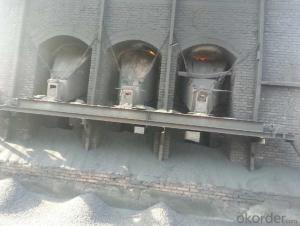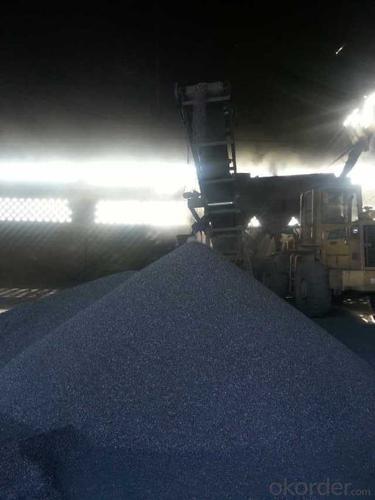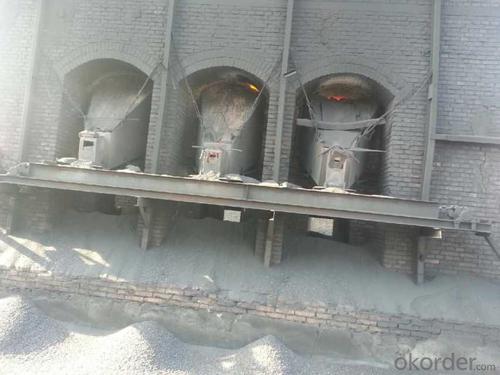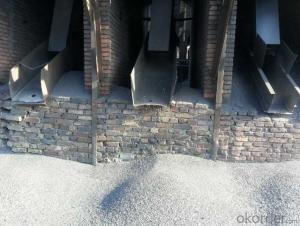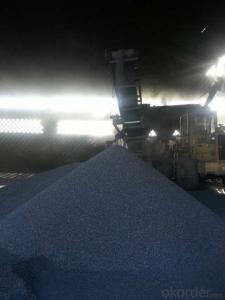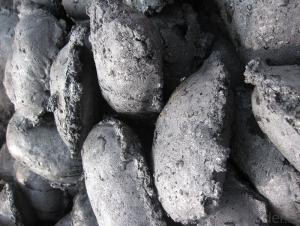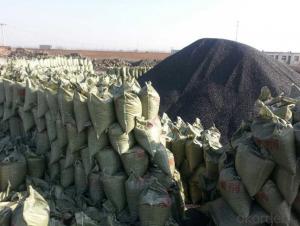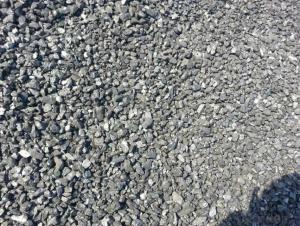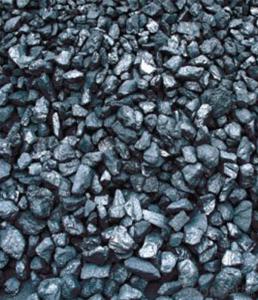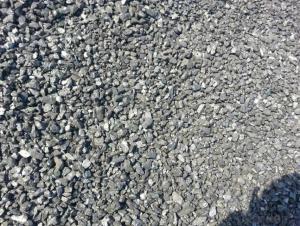Injection carbon FC93 with high and stable quality
- Loading Port:
- Tianjin
- Payment Terms:
- TT OR LC
- Min Order Qty:
- 20 m.t.
- Supply Capability:
- 3000 m.t./month
OKorder Service Pledge
OKorder Financial Service
You Might Also Like
Packaging & Delivery
25kgs/50kgs/1ton per bag or as buyer's request
Specifications
Calcined Anthracite
Fixed carbon: 90%-95%
S: 0.5% max
Size: 0-3. 3-5.3-15 or as request
It used the high quality anthracite as raw materials through high temperature calcined at over 2000 by the DC electric calciner with results in eliminating the moisture and volatile matter from anthracite efficiently, improving the density and the electric conductivity and strengthening the mechanical strength and anti-oxidation. It has good characteristics with low ash, low resistvity, low sulphur, high carbon and high density. It is the best material for high quality carbon products.
Advantage and competitive of caclined anthracite:
1. strong supply capability
2. fast transportation
3. lower and reasonable price for your reference
4.low sulphur, low ash
5.fixed carbon:95% -90%
6..sulphur:lower than 0.3%
General Specification of Calcined Anthracite:
| FC | 95 | 94 | 93 | 92 | 90 |
| ASH | 4 | 5 | 6 | 6.5 | 8.5 |
| V.M. | 1 | 1 | 1 | 1.5 | 1.5 |
| S | 0.3 | 0.3 | 0.3 | 0.35 | 0.35 |
| MOISTURE | 0.5 | 0.5 | 0.5 | 0.5 | 0.5 |
Pictures
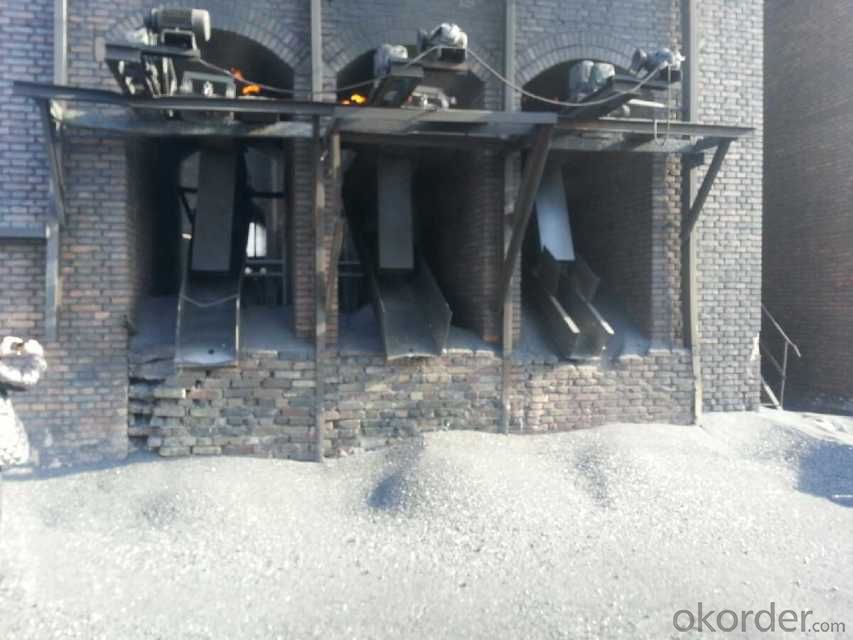
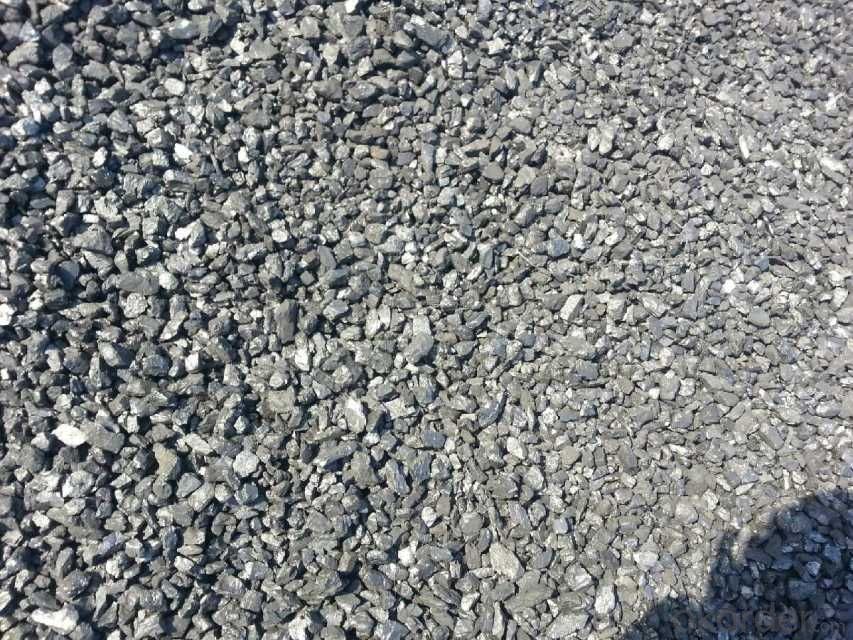
- Q: How does carbon contribute to the strength of concrete?
- There are several ways in which carbon can contribute to the strength of concrete. One primary method involves the utilization of carbon nanotubes (CNTs) or carbon fibers. These substances are added to the concrete mixture to act as reinforcement and enhance its mechanical properties. Incorporating CNTs or carbon fibers into the concrete results in the formation of a network consisting of small, sturdy, and lightweight particles. This network serves to enhance the overall strength and durability of the concrete, making it more resistant to cracking, flexing, and other types of structural damage. Furthermore, the carbon particles also improve the bonding between the cement paste and the aggregates in the concrete. This improved bonding increases the strength at the interface, resulting in a more cohesive and robust concrete matrix. Moreover, carbon can also contribute to the strength of concrete by acting as a pozzolan. Pozzolans are materials that undergo a chemical reaction with calcium hydroxide, a byproduct of cement hydration, to form additional cementitious compounds. These compounds fill in the gaps between cement particles, leading to a denser and stronger concrete structure. Carbon black, which is a finely divided form of carbon, is commonly used as a pozzolan in concrete mixtures. Overall, the incorporation of carbon in concrete, whether through carbon nanotubes, carbon fibers, or as a pozzolan, can significantly enhance its strength and performance. By reinforcing the concrete matrix, improving bonding, and filling in gaps, carbon helps create a more durable and robust material suitable for various construction applications.
- Q: How is carbon used in the production of pharmaceuticals?
- Pharmaceutical production relies on carbon for various purposes. One key application is in the synthesis of organic compounds, which serve as the foundation for numerous medications. Carbon atoms act as the building blocks for these compounds, enabling the formation of intricate structures found in pharmaceutical molecules. Additionally, carbon finds use in the creation of active pharmaceutical ingredients (APIs). APIs are the components responsible for delivering the desired therapeutic effects of drugs. Carbon is frequently incorporated into the structure of APIs to enhance their stability, bioavailability, and effectiveness. By modifying carbon-based molecules, their properties can be fine-tuned, optimizing their ability to target specific diseases or conditions. Furthermore, carbon plays a role in the purification and separation processes employed during pharmaceutical production. Activated carbon and other carbon-based adsorbents are commonly utilized to eliminate impurities and contaminants from drug formulations. These adsorbents possess a large surface area and effectively bind to and remove unwanted substances, ensuring the purity and safety of pharmaceutical products. Moreover, carbon contributes to the development of drug delivery systems. Carbon nanomaterials, including carbon nanotubes and graphene, exhibit unique properties that make them suitable for drug delivery applications. These nanomaterials can encapsulate drugs, enabling controlled release and precise targeting of specific tissues or cells. Additionally, they improve the solubility and stability of drugs, thereby enhancing their therapeutic potential. In conclusion, carbon is indispensable to the pharmaceutical industry. Its involvement spans the synthesis of organic compounds, the creation of active pharmaceutical ingredients, the purification of drugs, and the development of drug delivery systems. The versatility and ability of carbon to form complex structures establish it as an essential element in pharmaceutical production.
- Q: What is carbon fixation in biology?
- Carbon fixation is the process by which carbon dioxide from the atmosphere is converted into organic compounds by plants, algae, and some bacteria. This process is crucial for the production of organic matter and the maintenance of a stable carbon cycle on Earth.
- Q: What are the advantages of carbon-based solar cells?
- The advantages of carbon-based solar cells include their low cost and abundance of raw materials, as carbon is a widely available element. They also exhibit high efficiency and can be flexible, lightweight, and transparent, allowing for diverse applications. Additionally, carbon-based solar cells have a low environmental impact and can be easily manufactured using scalable techniques.
- Q: What is carbon neutral manufacturing?
- Manufacturing goods while minimizing or offsetting carbon emissions is what carbon neutral manufacturing is all about. The goal is to reduce greenhouse gas emissions at every stage of the manufacturing process, from obtaining raw materials to disposing of finished products. Achieving this involves various measures, such as improving energy efficiency, utilizing renewable energy sources, implementing sustainable practices, and investing in carbon offset projects. To become carbon neutral, manufacturers typically start by conducting a comprehensive assessment of their carbon footprint. This involves identifying and quantifying all emissions generated in their operations, including both direct emissions from manufacturing processes and indirect emissions from energy sources. Once emissions are measured, manufacturers can devise strategies to decrease their carbon footprint. Common methods for achieving carbon neutrality in manufacturing include optimizing energy consumption through efficient equipment and technologies, adopting renewable energy sources like solar or wind power, and implementing waste reduction and recycling programs. Additionally, manufacturers can invest in carbon offset projects that aim to reduce or eliminate greenhouse gas emissions, such as reforestation or renewable energy initiatives. By implementing these measures and offsetting any remaining emissions, manufacturers can achieve carbon neutrality. This not only helps combat climate change by reducing overall carbon footprints but also demonstrates a commitment to sustainability and environmental responsibility. Carbon neutral manufacturing is an important step towards transitioning to a low-carbon economy and creating a more sustainable future.
- Q: How does carbon impact the prevalence of landslides?
- The prevalence of landslides is significantly influenced by carbon dioxide (CO2) in the form of carbon. One of the main ways carbon affects landslides is by contributing to climate change. The increase in CO2 levels in the atmosphere causes global warming, which changes weather patterns, precipitation levels, and the overall stability of slopes and landforms. Carbon emissions leading to climate change result in more frequent and intense rainfall events in many areas. This heightened rainfall saturates the soil and raises groundwater levels, making slopes more prone to landslides. Additionally, intense rainfall erodes the soil, further compromising slope stability and increasing the chances of landslides. Another impact of carbon on landslide prevalence is its influence on vegetation. Carbon dioxide is crucial for photosynthesis, the process plants use to convert sunlight into energy. However, elevated CO2 levels can negatively affect plant growth and productivity. Plants play a vital role in stabilizing slopes and preventing erosion through their extensive root systems. When carbon levels are high, plants may experience stunted growth, weakening their ability to anchor the soil and protect against landslides. Furthermore, carbon emissions contribute to the melting of glaciers and permafrost, which can trigger landslides in mountainous regions. Glaciers serve as natural stabilizers, holding large amounts of rock and soil in place. When glaciers melt due to global warming, the sudden release of this material can trigger landslides with devastating consequences. In conclusion, carbon primarily impacts the prevalence of landslides through its contribution to climate change and subsequent effects on weather patterns, vegetation growth, and slope stability. It is crucial to address carbon emissions and mitigate climate change to reduce the occurrence and severity of landslides.
- Q: What is carbon black filler?
- Carbon black filler is a type of material made from fine particles of carbon that is added to various products, such as rubber, plastics, and inks, to improve their strength, durability, and color.
- Q: How does carbon impact the formation of smog?
- The formation of smog is greatly influenced by carbon, specifically carbon monoxide (CO) and volatile organic compounds (VOCs). When fossil fuels are burned, like in vehicle engines or power plants, they release carbon monoxide into the air. This colorless and odorless gas can react with other pollutants under sunlight to create ground-level ozone, a major part of smog. Moreover, volatile organic compounds (VOCs), which are carbon-based compounds, are also emitted from various sources such as industrial processes, gasoline vapors, and chemical solvents. These VOCs can undergo chemical reactions with nitrogen oxides and sunlight, resulting in the formation of ground-level ozone. Both carbon monoxide and VOCs contribute to the creation of smog by reacting with nitrogen oxides (NOx) when exposed to sunlight. This reaction produces ground-level ozone, which is a primary component of smog. Ozone is detrimental to human health and the environment, and the presence of carbon emissions worsens its formation. To mitigate the formation of smog, it is crucial to reduce carbon emissions. Transitioning to cleaner and more sustainable energy sources, such as renewable energy, can help decrease the release of carbon into the atmosphere. Additionally, implementing stricter emissions standards for vehicles and industrial processes can also play a role in reducing carbon emissions and consequently limiting the formation of smog.
- Q: How does carbon impact the availability of clean drinking water?
- The availability of clean drinking water can be significantly affected by carbon through various processes. One major way carbon impacts water quality is through the formation of acid rain caused by carbon dioxide emissions. When carbon dioxide combines with water in the atmosphere, it forms carbonic acid, which can be extremely harmful to water bodies. Freshwater sources can be devastated by acid rain, primarily caused by the release of carbon emissions from industrial activities and the burning of fossil fuels. This can result in a decrease in the pH level of lakes, rivers, and groundwater, making the water more acidic. The increased acidity can harm aquatic life, destroy ecosystems, and make water sources unsuitable for drinking, agriculture, or industrial use. Furthermore, carbon can affect the availability of clean drinking water through its role in climate change. Excessive carbon emissions contribute to the greenhouse effect, leading to rising global temperatures and changes in weather patterns. These changes can cause prolonged droughts and intense rainfall events, both of which can have negative effects on water availability and quality. Climate change-induced droughts can cause water scarcity as precipitation patterns become less predictable and water sources dry up. This can result in conflicts over limited water resources and force communities to rely on contaminated or unsafe water sources. Conversely, intense rainfall events caused by climate change can lead to flooding, overwhelming sewage systems and contaminating drinking water with pollutants and pathogens. Additionally, carbon emissions are linked to the degradation of natural ecosystems, such as forests and wetlands, which play a crucial role in water purification. Forests act as natural filters, absorbing carbon dioxide and releasing oxygen, while wetlands naturally filter and cleanse water. When these ecosystems are destroyed or degraded due to deforestation or drainage, the availability of clean drinking water is further compromised. To conclude, carbon emissions have a significant impact on the availability of clean drinking water. Acid rain formation, climate change-induced droughts and floods, and the degradation of natural ecosystems all contribute to water scarcity and contamination. It is crucial to protect and reduce carbon emissions in order to ensure the availability of clean drinking water for both present and future generations.
- Q: What is the role of carbon in organic chemistry?
- Carbon is the backbone of organic chemistry as it has the unique ability to form covalent bonds with other carbon atoms and a wide variety of other elements, resulting in the vast diversity of organic compounds. It is the element that allows for the formation of complex molecules, such as carbohydrates, proteins, lipids, and nucleic acids, which are essential for life processes.
Send your message to us
Injection carbon FC93 with high and stable quality
- Loading Port:
- Tianjin
- Payment Terms:
- TT OR LC
- Min Order Qty:
- 20 m.t.
- Supply Capability:
- 3000 m.t./month
OKorder Service Pledge
OKorder Financial Service
Similar products
Hot products
Hot Searches

